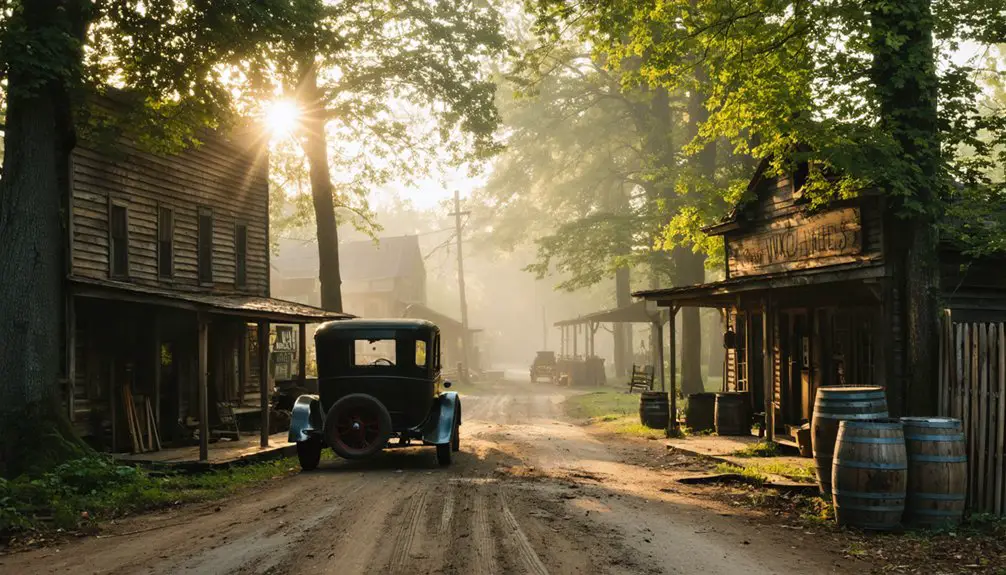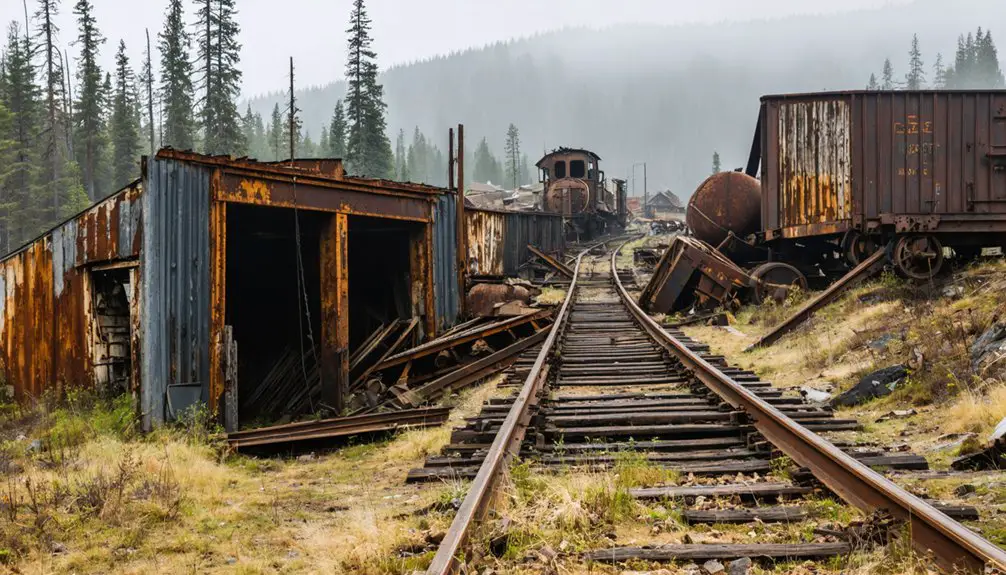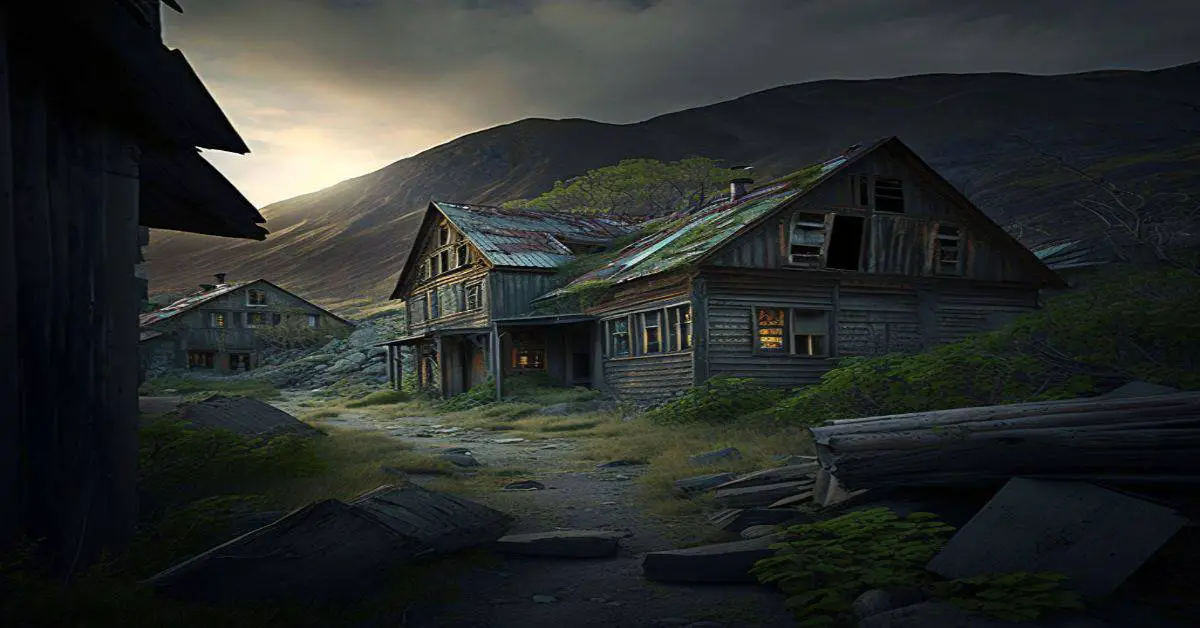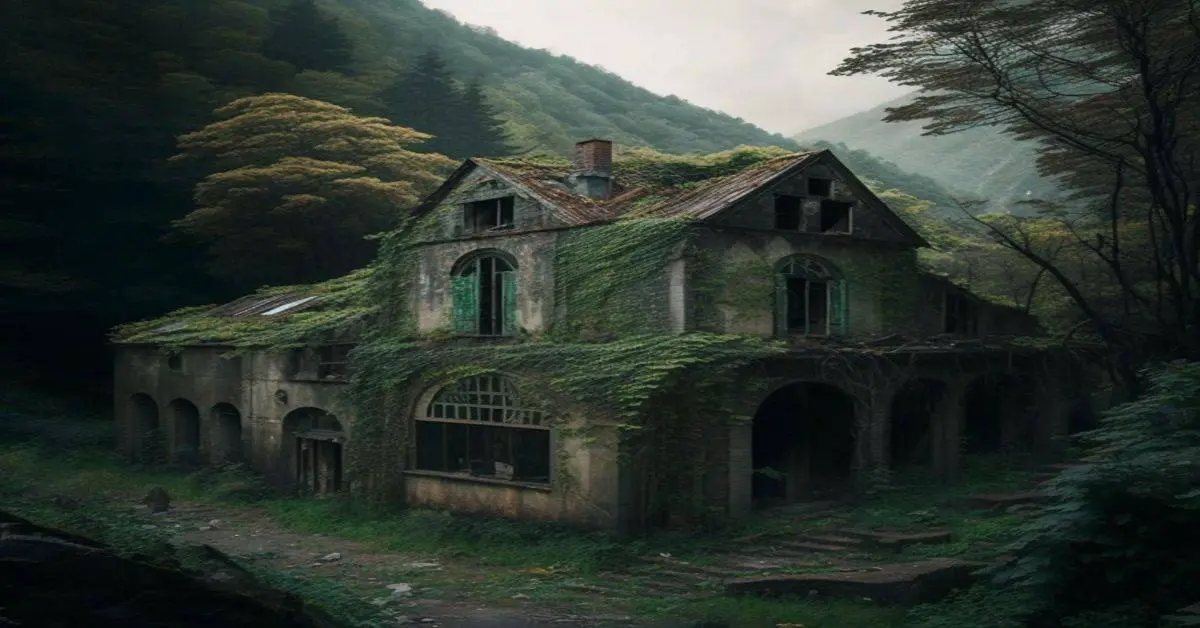You’ll find Herron, Michigan in Alpena County, where Fred Herron established this mining town in 1920. The community thrived around iron ore, gold, and uranium mining operations, with two general stores, modest houses, and a central Methodist church serving mining families. A tragic methane gas explosion in 1952 marked a turning point, leading to the town’s decline. Today, nature reclaims the abandoned structures while deep mine shafts and ruins hold countless stories of Michigan’s industrial past.
Key Takeaways
- Herron was established in 1920 as a Michigan mining town by Fred Herron, featuring general stores, houses, and a church.
- The town primarily focused on iron ore, gold, and uranium mining, with vertical shafts reaching depths up to 280 feet.
- A catastrophic methane gas explosion in 1952 killed five people and accelerated the town’s economic decline and eventual abandonment.
- The Boyne City, Gaylord & Alpena Railroad made Herron a regional commerce hub, evidenced by remaining railroad infrastructure.
- Today, nature has reclaimed the abandoned structures, transforming Herron into an explorable ghost town with designated trails.
The Early Days of Herron (1920)

When Fred Herron established his namesake settlement in 1920, the small Michigan mining town quickly took shape around a cluster of essential buildings southwest of Alpena.
The early settlement revolved around mineral extraction operations, with water pumps working continuously to keep the deep shafts clear for miners. You’d have found two general stores serving the growing community, alongside modest houses and a church where mining families gathered. In 1952, a tragic methane gas explosion forever changed the town’s history. Like the old sawmill ruins still visible in Shelldrake, these mining structures stood as testament to Michigan’s industrial past.
Water pumps churned day and night as miners worked below, while above ground, general stores and a church served their growing families.
Mining safety remained paramount as workers descended into shafts reaching 180 feet below ground. The newly established post office put Herron on the map, connecting this frontier community to the outside world.
Despite its remote location, the town sustained itself through a combination of commercial activity and the steady work provided by the mines.
Fred Herron’s Mining Vision
Behind the founding of Herron lay an ambitious mining vision that shaped the town’s early development. Fred Herron, who established the community in 1920, envisioned a thriving mining operation that would harness the region’s rich iron ore deposits using advanced mining techniques of the era.
His extensive plan focused on ore processing through charcoal pig-iron production, taking advantage of Michigan’s abundant forests for fuel. Similar to many early settlers, the miners who came to work in Herron were Cornish immigrants seeking opportunities in Michigan’s mines. Later mining efforts in the area led to tragedy when the Herron Blast killed five during uranium ore exploration in 1952.
- Herron’s operation planned to mirror the successful iron mining districts of Michigan’s Upper Peninsula, targeting hematite and magnetite ores.
- The vision included state-of-the-art furnace construction and ore extraction methods adapted to local geological conditions.
- Transportation logistics played a vital role, with plans for moving both raw ore and processed pig-iron to market.
You’ll find evidence of this vision in the 180-foot deep shafts that remain today, proof of the scale of Herron’s mining ambitions.
Life in a Michigan Mining Town
If you’d lived in Herron during its mining heyday, you’d have experienced long days of grueling underground work followed by simple pleasures like community dances and baseball games.
Your neighbors would likely have included immigrant families drawn by mining jobs, forming tight-knit ethnic communities that preserved their cultural traditions through shared meals, religious services, and celebrations.
Many of your fellow miners would have been Cornish immigrants who brought their expertise from England to work in the mines.
Despite the harsh working conditions and modest company housing, residents built strong social bonds through mutual aid societies, union meetings, and gatherings at the local church and school. The mining industry brought significant wealth to the region, serving as the economic backbone of Michigan’s Copper Country for over a century.
Daily Mining Town Life
Life in Michigan’s mining towns revolved around the demanding rhythms of the mines, where workers endured harsh conditions while building tight-knit communities. Your daily routines centered on mining hazards, as you’d pay $0.50 monthly for medical coverage and accept workplace risks as normal. If you couldn’t work, your family had to leave company housing within 60 days. If hospitalized, you would be charged $1.00 per day for care. The Central Methodist Church became the heart of community life, hosting social gatherings and Christmas services.
- You’d live in a six-room boarding house for $1.00 monthly, sharing space with other workers in crowded conditions.
- Your children might work alongside you in the mines instead of attending school.
- Your wife would likely manage the household, take in boarders, and contribute to the local economy.
The town’s infrastructure grew around you, from the stamp mill to the saloon, creating a self-contained world where everyone played their part in survival.
Community and Social Bonds
Within Herron’s tightly woven social fabric, you’d find a community built on multiple pillars of connection – the founding Herron family’s agricultural roots, the Boyne City railroad’s economic lifeline, and the dangerous yet unifying work of mining exploration.
You’d witness remarkable community resilience through the town’s social networks, especially during the tragic 1952 mine explosion that claimed five lives. The sole survivor, John Pastuszka, became a living testament to the dangers faced by local miners.
The local church served as both spiritual anchor and community hub, while the general store and post office fostered daily interactions among residents. These gathering spots strengthened bonds between farming families and miners, creating an intricate web of support and mutual dependence.
Whether through shared labor in the fields, coordinated mine rescue efforts, or religious ceremonies, Herron’s residents maintained their close-knit identity through both prosperity and hardship. The community often gathered for special celebratory railroad dinners to honor officials and commemorate the railway service that connected their town to the wider region.
The 1952 Mine Explosion Tragedy
On the night of October 30, 1952, a devastating methane gas explosion ripped through Herron’s abandoned mine shaft, claiming five lives and forever changing this small Michigan community. The blast, likely triggered by an electric drill, instantly killed mine operator John Wilczynski and four local men, demonstrating the critical importance of mine safety in Michigan’s ghost towns.
- The explosion’s force hurled heavy I-beams 300 feet from the mine entrance.
- Two victims remained trapped in the water-filled shaft, while three bodies were recovered immediately.
- The community’s resilience showed as they carefully managed recovery efforts, prioritizing safety in the gas-filled environment.
The tragedy struck during uranium prospecting operations, highlighting the risks of exploring abandoned mines.
While one man survived, the incident left an indelible mark on Herron’s history, forever reminding us of the dangerous conditions these brave miners faced.
Mining Operations and Economic Impact

You’ll find Herron’s mining legacy centered on gold extraction and uranium prospecting, with operations reaching depths of 180 to 280 feet through vertical shafts that required constant water management.
The town’s economic significance depended on these mining activities, supported by critical railroad connections that transported minerals and mining supplies in and out of the community.
While mining initially brought jobs and growth to Herron, the combination of technical challenges like groundwater control and inconsistent mineral yields ultimately led to the operation’s closure and the town’s economic decline.
Gold and Uranium Mining
Mining operations in Herron revolved around two distinct phases: gold extraction in the early 1950s and subsequent uranium prospecting, both centered at a 280-foot vertical shaft mine.
You’ll find that Herron Alpena Enterprises initially focused on gold extraction, installing water pumps and conducting rock sampling before shifting their attention to uranium exploration during the post-war uranium boom.
Key aspects of Herron’s mining history:
- The mine’s infrastructure included essential water pumps and railroad connections for transporting materials.
- Operations remained mostly exploratory, with modest crews conducting sampling work.
- A tragic methane explosion in 1952 killed five men during uranium prospecting, effectively ending major mining activities.
The limited scale of both gold extraction and uranium exploration meant Herron’s mines never achieved significant commercial success, contributing to the area’s eventual decline.
Economic Rise and Fall
While Herron’s early economic prospects centered on gold and uranium exploration, the town’s industrial base actually diversified through operations like the Paxton Quarry, which supplied essential gravel and stone for regional construction projects.
The Detroit & Mackinac Railroad‘s presence made these mining techniques viable by connecting Herron’s resources to broader markets.
Yet the community’s resilience was tested by tragic events, including a devastating 1952 explosion that killed five men in an abandoned mine shaft.
This disaster, combined with declining mining profits and safety concerns, accelerated Herron’s economic downturn.
As quarry operations ceased and exploratory mines closed, the town lost jobs and population.
Though some families like the Herrons adapted through farming, the end of mining operations ultimately led to Herron becoming a ghost town.
Transportation and Infrastructure
Because transportation played a vital role in Herron’s development, the Boyne City, Gaylord & Alpena Railroad established a station there around 1920, positioning it between Martin’s store and Domke’s elevator.
Railroad logistics transformed this rural community into a bustling hub for regional commerce, while coal transportation kept local homes and schools warm through harsh Michigan winters.
You’ll find evidence of Herron’s transportation legacy in these key features:
- A 35′ x 9′ boxcar still stands near Domke’s elevator, a reminder of freight storage operations.
- The rail siding by Martin’s store where cars switched for loading various goods.
- Local roads where converted trucks, like a 1923 Dodge, hauled coal from rail yards.
This integrated network of rail and road infrastructure supported everything from logging camps to gold mining operations, keeping Herron connected to broader markets.
Natural Reclamation and Modern Remnants
As nature steadily reclaims the abandoned town of Herron, you’ll find native forests and thick brush overtaking what were once busy streets and building foundations.
The site has evolved into a natural habitat where deer, foxes, and diverse bird species thrive among the crumbling ruins. Stone foundations, rusted mining equipment, and weathered gravestones offer glimpses of the past while serving as shelter for local wildlife.
Lake Superior’s influence creates a unique microclimate that’s hastening decay, as moisture, freeze-thaw cycles, and erosion break down the remaining structures.
Despite this deterioration, you can explore the ghost town via designated trails, where informational signs highlight the area’s remarkable ecological balance.
Remember to tread lightly – the delicate ruins and regenerating ecosystem require protection as nature continues its gradual transformation of this historic site.
Historical Significance in Alpena County
Founded in 1920 by Fred Herron, this once-bustling mining settlement became a significant part of Alpena County’s industrial heritage.
Standing at the crossroads of indigenous heritage and mining legacies, Herron’s story reflects the dramatic change of northern Michigan’s landscape. The town’s development mirrored the broader regional shift from Native American territories to resource extraction sites.
Herron embodies Michigan’s transformation, where ancestral Native lands gave way to industrial ventures and mining aspirations.
- You’ll find traces of Ottawa, Chippewa, and Pottawatomi history near Thunder Bay River, where indigenous villages once thrived.
- The 1952 mine explosion that claimed five lives marks a pivotal moment in the county’s industrial history.
- Herron’s abandoned structures serve as stark reminders of the boom-bust cycle that shaped many northern Michigan communities.
Today, these remnants tell a complex story of cultural evolution, industrial ambition, and the price of progress.
Legacy of Michigan’s Resource Towns
Throughout Michigan’s industrial era, resource towns like Herron emerged as vibrant hubs of economic activity, drawing diverse immigrant populations who shaped the state’s cultural landscape.
You’ll find their legacy deeply woven into Michigan’s social fabric, from the ethnic churches and union halls that once anchored community life to the folk traditions and cultural celebrations that continue today.
While many resource towns faced decline due to poor resource management and economic shifts, they’ve left an enduring imprint on the state’s identity.
Their stories live on through preservation efforts, local museums, and heritage tourism initiatives. Archaeological sites and restored buildings offer glimpses into the lives of Finnish, Italian, and Cornish immigrants who built these communities.
Though some towns became ghosts, their influence on Michigan’s development, environmental awareness, and cultural diversity remains significant.
Frequently Asked Questions
What Happened to Fred Herron After the Town’s Decline?
Time waits for no man, as Fred Herron passed away in 1948, years before the town’s decline. His legacy lived on through Herron family descendants, though he rests peacefully in Wilson Township Cemetery.
Were There Any Other Major Accidents Before the 1952 Disaster?
You won’t find records of previous accidents at this site before 1952. Historical documents and mining safety reports suggest the gold mine operated without major incidents until its abandonment and the fatal uranium prospecting disaster.
Did Any Families From Herron Relocate Together to Another Community?
While you’d expect strong family migration patterns, there’s no documented proof of specific families relocating together, though community ties and shared mining backgrounds suggest groups likely moved to nearby active mining towns.
What Was the Peak Population of Herron During Its Mining Days?
You’ll find records of mining industry population growth are limited, though based on comparable Upper Peninsula towns of the era, peak numbers likely ranged between several hundred to a few thousand residents.
Are There Any Surviving Photographs of Herron During Its Active Years?
While you’ll find visual evidence of other Michigan ghost towns, available historic documentation hasn’t revealed any confirmed photographs of Herron during its active period, though local archives may hold undiscovered images.
References
- https://lostinmichigan.net/the-herron-explosion/
- https://en.wikipedia.org/wiki/Herron’s_Mills
- https://usminedisasters.miningquiz.com/saxsewell/1952_Herron_Report.pdf
- https://kids.kiddle.co/List_of_ghost_towns_in_Michigan
- https://michiganrailroads.com/mines-and-mining/206-eastern-upper-northeast-lower/6343-herron-alpena-enterprises
- https://975now.com/shelldrakemichigan/
- https://lostinmichigan.net/category/ghost-towns/page/5/
- https://99wfmk.com/junet-montreal-ghost-towns/
- https://www.onlyinyourstate.com/experiences/usa/american-ghost-towns
- https://www.michigan.gov/-/media/Project/Websites/egle/Documents/Programs/GRMD/Catalog/09/GIMDL-VOLIA.PDF?rev=f63660f67590492a8113e46ba8de670d


